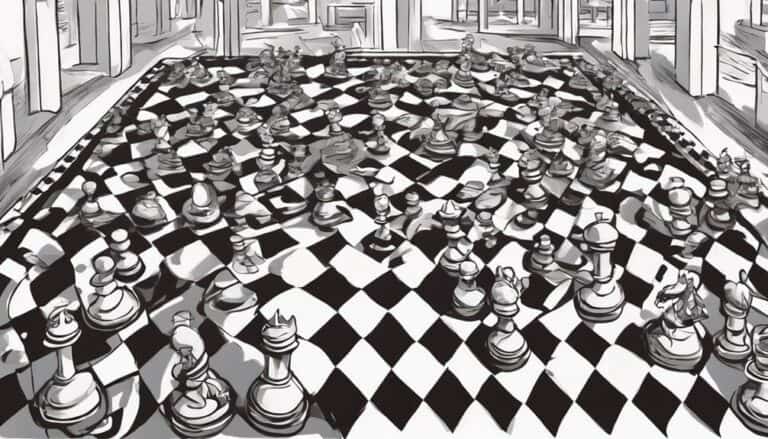Imagine you are a manager at a tech company facing a pivotal decision: whether to invest in developing a groundbreaking new product line that could revolutionize the industry. This choice exemplifies the essence of strategic decision-making.
But how does this differ from the tactical decisions required to guarantee the day-to-day operations run smoothly?
Understanding the nuances between strategic and tactical decision-making is essential for effective leadership and organizational success.
Key Takeaways
- Strategic decision-making shapes long-term direction and vision.
- Tactical decision-making focuses on short-term operational efficiency.
- Strategic decisions impact organizational growth and competitive positioning.
- Balancing strategy and tactics is crucial for effective leadership and goal achievement.
Key Characteristics of Strategic Decision-Making
When crafting strategic decisions, it's imperative to meticulously assess the long-term objectives and overarching direction of the organization. Strategic decisions play a pivotal role in shaping the future trajectory of the organization. By focusing on long-term goals, high-level management can align these decisions with the organization's mission and vision, ensuring a cohesive strategic approach. Analyzing external factors, competition, market trends, and future opportunities are key components of strategic decision-making. This thorough assessment not only enhances understanding of the business environment but also enables proactive responses to potential challenges and opportunities.
Moreover, strategic decisions set the course for the organization's future and determine its competitive position in the market. By making better strategic decisions, organizations can adapt to changing market dynamics, capitalize on emerging trends, and stay ahead of the competition. Understanding the nuances of strategic decision-making is essential for steering the organization towards sustained success and long-term growth.
The Nature of Tactical Decision-Making
Tactical decision-making, characterized by its focus on short-term operational choices and swift responsiveness to immediate needs, plays an important role in executing the broader strategic vision of an organization. Decisions made at this level are pivotal in bridging the gap between strategic goals and day-to-day operations.
- Immediate Action: Tactical decisions prioritize taking immediate action to address pressing operational issues promptly.
- Alignment with Strategy: These decisions are intricately linked to the organization's strategic objectives, ensuring that day-to-day activities contribute to the long-term vision.
- Operational Efficiency: Tactical decision-making emphasizes operational efficiency by streamlining processes and allocating resources effectively to achieve short-term goals.
Decisiveness and adaptability are essential traits in tactical decision-making, as it requires a keen understanding of how each choice contributes to the larger strategic framework. By focusing on the practical implementation of strategic directives, tactical decisions drive the organization towards its overarching goals with precision and agility.
Strategic Vs. Tactical Decision-Making Process
In understanding the distinction between strategic and tactical decision-making processes, it is imperative to recognize the fundamental difference in their temporal scopes and organizational impacts. Strategic decision-making involves setting the long-term direction and priorities of an organization, while tactical decision-making focuses on the short-term implementation and operational aspects. The table below further highlights the key disparities between strategic and tactical decision-making processes:
| Criteria | Strategic Decision-Making | Tactical Decision-Making |
|---|---|---|
| Time Horizon | Long-term | Short-term |
| Organizational Impact | Significant | Limited |
| Focus | External factors and growth | Internal operations and efficiency |
Strategic decisions shape the overall vision and growth trajectory of the organization, requiring a broad perspective and consideration of external factors. On the other hand, tactical decisions are more operational and immediate, aiming to execute the strategic plans effectively. Understanding the nuances between strategic and tactical decision-making processes is vital for effective organizational management and goal achievement.
Impact of Strategic Decisions on Long-Term Goals
Strategically shaping an organization's long-term goals requires astute foresight, meticulous planning, and a keen understanding of market dynamics. When making strategic decisions, consider the following:
- Make a Difference Between Strategic and Tactical: Strategic decisions have a profound impact on an organization's long-term goals, setting the direction and vision for the future. These decisions are pivotal in determining the overall success and sustainability of the enterprise.
- Align with Long-Term Objectives: Strategic decisions are carefully crafted to make certain they align with the organization's long-term goals, competitive positioning, and desired growth trajectory. They serve as a roadmap guiding the company towards its envisioned future state.
- Drive Sustainable Growth: Strategic decisions are instrumental in driving sustainable growth by leveraging market insights, industry trends, and internal capabilities. They lay the foundation for lasting success and competitive advantage in the dynamic business landscape.
Balancing Strategy and Tactics in Leadership
To achieve effective leadership, it's imperative to harmonize the strategic vision with the tactical execution, ensuring seamless alignment towards organizational goals.
The journey of balancing strategy and tactics in leadership begins with the ability to start decisively by setting a clear strategic direction that outlines the long-term objectives and desired outcomes. This initial step lays the foundation for the subsequent tactical decisions that will bring the strategic vision to fruition.
As a leader, you must make decisions that not only start the process but also guide its trajectory towards the desired end. Effective leadership requires a delicate interplay between strategic foresight and tactical adaptability, ensuring that each decision made contributes to the overall success of the organization.
By empowering your teams to execute on tactical decisions that support the overarching strategic goals, you create a synergy that propels the organization towards its intended destination.
Conclusion
As you reflect on the differences between strategic and tactical decision-making, remember that the key to success lies in finding the delicate balance between the two.
By understanding the long-term impact of strategic decisions and the day-to-day execution of tactical decisions, you can steer your organization towards sustainable growth and achievement.
Embrace the challenge of blending strategy and tactics to propel your organization to new heights, and watch as your leadership skills flourish in the process.

